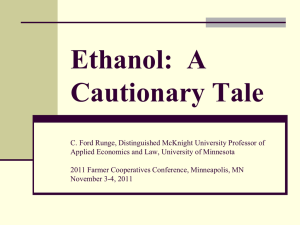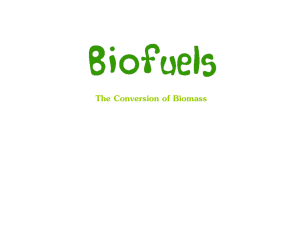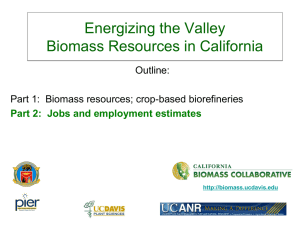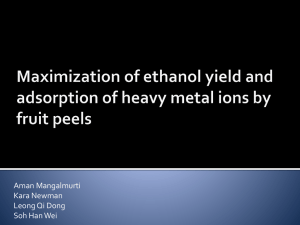DOWNLOAD THE PRESENTATION (pdf)
advertisement
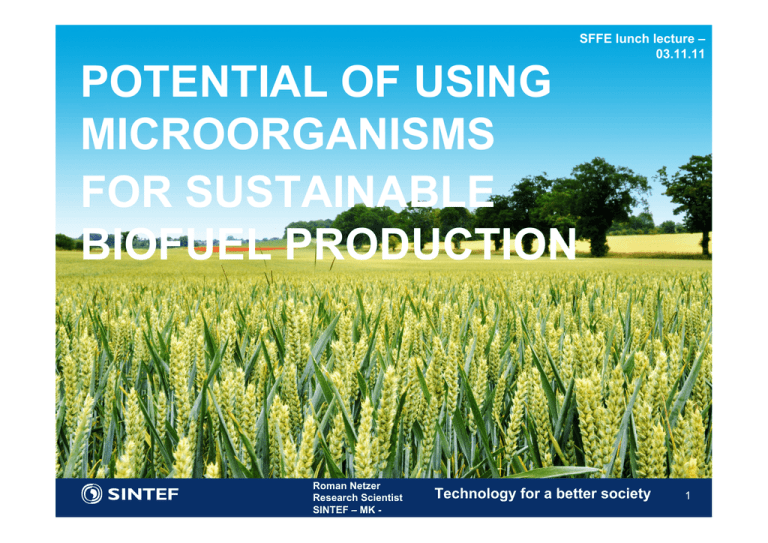
POTENTIAL OF USING MICROORGANISMS FOR SUSTAINABLE BIOFUEL PRODUCTION Roman Netzer Research Scientist SINTEF – MK - SFFE lunch lecture – 03.11.11 Technology for a better society 1 STRUCTURING Introduction - SINTEF – Materials and Chemistry – Biotechnology - What is biofuel and why using it? - Statistical data and predictions - Overview over different types biofuels - History of biofuels Biotechnology and 2G biofuels Lignocellulosic biomass for 2G bioethanol production - Role of microorganisms for ethanol production - Important biochemical pathways for biotechnological biofuel production - Modification of yeast strains for biofuel production and biorefinery - Consolidated bioprocess for bioethanol production The LignoRef project Materialer og kjemi 2 2 SINTEF – MK – DEPARTMENT OF BIOTECHNOLOGY FROM GENE TO PRODUCT Strain development Cultivations in well-plates Robotized colonypicking and liquid handling Fermentors for process optimizations High-throughput screening and analyses Product isolation and purification Pilot scale equipment Materialer og kjemi 3 WHAT IS BIOFUEL? Fuel whose energy is derived from recent biological carbon fixation in contrast to fossil fuels such as coal, petroleum, or natural gas that come from long since dead plants and microorganisms. Biofuels address the main issues 1. Carbon neutral 2. Renewable & Integral part of emerging economy 3. Sustainable 4. Local production (also small scale) Materialer og kjemi 4 4 WHY USING BIOFUELS? Reduction of GHG emissions CO2 released by burning biofuel already existed as part of the modern carbon cycle. Potential to become carbon neutral in the future. Price Prices for fossil fuels will increase due to limited availability and increasing demand and production costs. Prices for biofuels are suggested to decrease due to progress in production technology. Independence Compared to fossil fuels, biofuels are easy to produce No monopolistic/oligopolistic market. Availability It's renewable. Biofuels can be produced from raw agricultural/waste materials. Worldwide energy demand will increase in future. Materialer og kjemi 5 5 SCENARIO GLOBAL POPULATION DEVELOP Materialer og kjemi 6 SCENARIO FOR GLOBAL ENERGY CONSUMP Energy Information Administration http://www.eia.gov/forecasts/archive/ieo10/world.html Materialer og kjemi 7 7 DEVELOPMENT OF WORLDWIDE BIOFUEL PRODUCTION Energy Information Administration http://www.eia.gov/forecasts/archive/ieo10/world.html Materialer og kjemi 8 Ethanol production will again double over the next decade World Ethanol Production Mil Gal 45.000 40.000 All Others 35.000 India 30.000 China 25.000 EU-27 20.000 Brazil 15.000 U.S. 10.000 5.000 0 2000 2005 2009 2019 Source: OECD/FAO Materialer og kjemi 9 BIODIESEL PRODUCTION ALSO WILL GROW IN FUTURE World Biodiesel Production 12.000 All Others India Mil Gal 10.000 Brazil 8.000 Argentina U.S. 6.000 EU(27) 4.000 2.000 0 Avg 2007-2009 2019 Source: OECD/FAO Materialer og kjemi 10 NEGATIVE ASPECTS OF (CURRENT) BIOFUE Current biofuels compete with food for the same feedstocks. Food prices may further rise if areas once used to grow food are converted to grow energy crops. Rain forests and other tropical areas could be cleared to cultivate crops for biofuel production. Indirect land use change Increasing food prices could affect populations in developing countries. Materialer og kjemi 11 PIONEERS IN BIOFUEL TECHNOLOGY Henry Ford in front of his T-Model Ford "Tin Lizzie" (1908) (designed for ethanol) "There is fuel in every bit of vegetable matter that can be fermented." Rudolph Diesel's compression-ignition engine (1893) (designed for peanut oil) Materialer og kjemi 12 HISTORY OF BIOFUELS Bioethanol: 1824: Samuel Morey developed an engine that runs on ethanol and turpentine. 1860: Nicholas Otto uses ethanol as fuel in one of his engines. 1862: Special tax is placed on ethanol whiskey (Moonshine) in the U.S. to help pay for the Civil War. Ethanol falls out of favor as a fuel. 1896: Henry Ford builds his first automobile, and the engine is designed to run on pure ethanol. 1919-1933: Prohibition era in the U.S. makes it impractical to use ethanol cars. 1920s: Gasoline becomes the most popular fuel in the U. S. as well as in many other parts of the world. In Brazil, sugarcane based ethanol is produced as major car fuel 1945: Gasoline becomes cheap and easily accessible. This reduces the interest in ethanol cars. From 1970s: Oil crisis in 1973 and 1979 Environmental concerns (Global warming/air pollution/GHG emission) Idea of using biofuels was revitalized in the U.S. and Europe Materialer og kjemi 13 IMPORTANT BIOFUELS Bioalcohols - Ethanol Most common and best established biofuel Produced by fermentation processes from sugars by microorganisms and enzymes Can be used in petrol engines (existing car engines up to 15% additive to gasoline) Lower energy density than gasoline (1/3 lower), corrosive effect Butanol Compared to ethanol: higher energy density, less corrosive, less water soluble (better engine fuel, requires less change regarding infrastructure and engine design) - Until 1950s produced by fermentation process (ABE fermentation) from starch using Clostridium acetobutylicum; substituted by petrochemical routes Materialer og kjemi - Suggested as substitute for jet fuels - 14 IMPORTANT BIOFUELS Biodiesel (FAME) • Most common type of biofuel used in European countries • Produced by transesterification from animal fats, vegetable oils, soy, rapeseed, jatropha, mahua, mustard, flax, sunflower, palm oil, hemp, field pennycress, pongamia pinnata and algae. Green (renewable) diesel Produced from renewable feedstocks by • Fischer Tropsch Synthesis from SynGas • Conversion of pyrolysis oil (BtL) • Catalytic conversion of sugar or lipids (algae) Materialer og kjemi 15 1st GENERATION BIOFUEL Produced from sugar, starch, vegetable oil, or animal fats Feedstocks can in most cases be used as food or feed Food vs. Fuel dilemma Technologies: fermentation, transesterification Most established biofuel production process Lower impact on reduction of green house gas emission Materialer og kjemi 17 ADVANCED BIOFUELS (2nd AND 3rd GENERAT Biofuels produced from sustainable feedstocks (e. g. lignocellulosic biomass, algae). Significant impact on GHG emissions: reduction of CO2 emissions up to 90% Examples: Ethanol Fischer-Tropsch fuels ((2n+1) H2 + n CO → CnH(2n+2) + n H2O) Biohydrogen, Biogas Most processes are currently still under development 3rd generation biofuels: - made out of microorganisms, primary microalgae - indistinguishable from petroleum counterparts Renewable Fuels Association Materialer og kjemi 18 BIOTECHNOLOGY Any technological application that uses biological systems, living organisms, or derivatives thereof, to make or modify products or processes for specific use. The United Nations Convention on Biological Diversity • Classic biotechnological applications Fermentation processes used in food production: bread, brewerage, milk products, conservation of food, ….. • Modern biotechnological applications – Therapeutics: antibiotics, insulin, vaccines, antibodies, enzymes, … – Carotenoids, vitamins, organic acids, polymers, …. – Processes for mining, wastewater treatment, oil spill recovery and other bioremedation, … – Amino acids: L-glutamate (1.200.000 t/a), L-lysine (600.000 t/a),… – Biofuels Materialer og kjemi 20 2nd GENERATION BIOETHANOL One material could cure our addiction to oil!? Lignocellulose •the most abundant naturally occurring organic material •Accounts to ca. 50% of the biomass in the biosphere •No direct concurrency with food production (but risk of ILUC) •Annual production world wide: 10 to 50 × 109 t Enormous and sustainable source of energy Materialer og kjemi 22 COMPOSITION OF LIGNOCELLULOSIC BIOMASS •Cellulose: polysaccharide consisting of a linear chain of several hundred to over ten thousand β(1→4) linked D-glucose units. •Hemicellulose: heteropolymer comprised of xylose linked backbone branched with other sugars like arabinose, mannose, galactose and glucose. •Lignin: cross-linked racemic macromolecule, relatively hydrophobic and aromatic in nature. The carbohydrate polymers (cellulose and hemicelluloses) are tightly bound to the lignin. Nature 454, 841-845 Materialer og kjemi 23 LIGNOCELLULOSIC FEEDSTOCKS Agricultural residues Wood residues Corn stover Wood chips Bagasse Sawdust Rice straw Paper mill waste Municipal waste Dedicated energy cro Municipal paper waste Biodegradable fraction of MSW Materialer og kjemi Elephant grass Willow 24 PRETREATMENT OF LIGNOCELLULOSIC BIOMASS Lignocellulosic biomass: rigid, resistent to biotic and abiotic stresses Pretreatment: a)Liberation of cellulose b)Efficient hydrolysis of cellulose and hemicellulose to its constituent sugars Access for enzymes and microorganisms Methods: 1.Physicochemical: pulping and steam explosion 2.Chemical: acid hydrolysis: acids are corrosive and hazardous. Efficient but expensive; Organosolv (90% cellulose conversion for forest biomass) 3.Biological: enzymatic hydrolysis: mild process without the formation of inhibitory byproducts; safe and environmentally friendly method Materialer og kjemi 25 RUNFLOW FOR LIGNOCELLULOSIC BIOMASS PROCESSING Biomass Biochemical conversion Steam explosio n NH3 NaS Cellulose Hemicellulose Acid catalysis Thermochemical conversion Organ o solv Lignin Enzyme catalysis Torrefactio n Oils Comb ustion Syngas Pyrolysi s Charcoal Fischer Tropsc h Upgrade Diesel C6 sugars C5 sugars Decarbox y lation Fermentatio n Fuels Food Feed Fine chemicals Fine chemicals Materialer og kjemi Alcohols Catalytic hydrogenatio n Fuels 26 BIOLOGICAL PRETREATMENT OF LIGNOCELLULOSIC BIOMASS Conversion of cellulose into glucose Chemical hydrolysis: diluted acid + heat/pressure => toxic by-products In nature cellulose can be broken down by specialized enzymes: Cellulases Concerted action of different cellulases: (a) Endoglucanases (EG) cleave cellulose chains at random positions (b) Exoglucanases (cellobiohydrolases, CBH) cleaves two (cellobiose) to four units from the ends of the exposed chains. Lynd et al., 2002 (c) β-Glucosidases (BG) hydrolyse cellobiose to glucose Ethanol fermentation by yeast Materialer og kjemi 27 CELLULOLYTIC ENZYMES FOR LIGNOCELLULOSE PRETREATMENT Cellulases/hemicellulases are of high industrial interest •Mainly produced by fungi, bacteria and protozoa •Often produced by symbiotic bacteria in the rumen of herbivores and guts of termites Materialer og kjemi 28 MICROORGANISMS PRODUCING CELLULOLYTIC ENZYMES Current Opinion in Microbiology 2003, 6:219–228 Materialer og kjemi 29 COMPOSITION OF LIGNOCELLULOSIC HYDROLYSATES sugars... Hydrolysed with diluted acid: HEXOSES C H2O H O OH OH glucose HO OH Lignin 21-32% CH 2 O H O OH Extractives 1-5% OH OH mannose HO Cellulose 33-51% HO C H2 O H O galactose OH OH OH HO O OH C H3 OH Hemicellulose 1934% rhamnose OH PENTOSES FERMENTATION INHIBITORS O OH OH HO xylose OH O OH arabinose OH HO H 2 C OH Materialer og kjemi 30 MICROORGANISMS CAPABLE OF ETHANOL FERMENTATION Microorganisms pH range Fusarium oxysporum 5-6 Neurospora crassa 5–6 Monilia sp. 5 Mucor sp. 5.4 Saccharomyces cerevisiae 3-7 Klyuvermyces marxians 3-7 Pachysolen tannophilus 2.5 - 7 Candida shehatae 3-7 Pichia stiptis - 32 3-7 Bacillus polymyxa 5.5 - 8 Aerobacter hydrophila 55 8 Glu Xyl Ara Man Cel Temp. range (°C) + + + + + 28 - 32 + + - - + 28 – 37 + + - - - 26 + + - - - 30 + + - - + - 30 - 35 + + + + - 30 - 35 + + + - - 28 - 32 + + + + + + + + + + + + +Materialer og + kjemi 28 - 32 + - - 35 - 37 - 35 - 37 28 31 S. CEREVISIAE IS A SUPERIOR MICROORGANISM FOR INDUSTRIAL PRODUCTION OF 2G BIOFUELS Among the best known microorganisms and genetic tools and methods are established GRAS (Generally Recognized as Safe) status Well established in production processes with a high robustness Some strains are highly resistant to toxic inhibitors and fermentation products Fermentation processes have a minimized contamination risk Fermentation process is easier to control compared to other microorganisms Use of yeast for butanol production: ethanol producers in facilities Brazil, Europe or Northuse America willand most likely have use a Main All ethanol production worldwide yeasts yeasts yeasts rather than bacteria should they switch from ethanol to butanol high acceptance among ethanol producers Materialer og kjemi 32 S. CEREVISIAE IS A SUPERIOR MICROORGANISM FOR INDUSTRIAL PRODUCTION OF 2G BIOFUELS HEXOSES CH 2 O H O OH efficiently ferments hexose sugars glucose OH HO OH CH 2 O H O OH OH mannose OH HO C H2 O H O HO galactose OH S. cerevisiae OH OH HO O OH C H3 OH rhamnose OH PENTOSES O OH but no pentose sugars OH HO xylose OH O OH arabinose OH HO H 2 C OH Materialer og kjemi 33 XYLOSE METABOLISM IN YEAST, FUNGI AND BACTERIA Type I (Yeast and fungi) Type II (Bacteria, some fungi) D-Xylose D-Xylose Xylose reductase (XR) NADPH NADH NADP+ NAD+ Xylose isomerase (XI) Xylitol Xylitol dehydrogenase (XDH) NAD+ NADH D-Xylulose D-Xylulose ATP ADP Xylulokinase (XK) ATP ADP D-Xylulose-5-P D-Xylulose-5-P PPW/Glycolysis PPW/Glycolysis ETHANOL ETHANOL Materialer og kjemi 34 XYLOSE METABOLISM IN S. CEREVISIAE S. cerevisiae wild-type D-Xylose NADPH ScXR NADP+ Wild type S. cerevisiae strains unable to utilize xylose for Xylitol NAD+ ScXDH growth NADH D-Xylulose ATP ScXK ADP XR, XDH and XK encoding genes present in the genome (very low expression levels) D-Xylulose-5-P Very slow growth on xylose has been observed even PPW/Glycolysis when the endogenous genes are overexpressed ETHANOL Materialer og kjemi 35 XYLOSE METABOLISM IN P. STIPITIS AND SOME OTHER YEASTS P. stipitis wild-type D-Xylose NADH NADPH PsXR NAD+ NADP+ Xylitol NAD+ PsXDH Able to ferment xylose to ethanol under anaerobic conditions NADH D-Xylulose General slower sugar consumption rate compared to S. ATP PsXK ADP D-Xylulose-5-P PPW/Glycolysis cerevisiae P. stipitis possess both NADPH- and NADH-specific XR No redox imbalance during xylose fermentation. ETHANOL Materialer og kjemi 36 GENETIC ENGINEERING OF S. CEREVISIAE (TYPE I PATHWAY) S. cerevisiae wild type Xylose fermenting S. cerevisiae mutant Materialer og kjemi 37 GENETIC ENGINEERING OF S. CEREVISIAE Xylose reductase (XR) and Xylitol dehydrogenase (XDH) D-Xylose NADPH NADH NADPH PsXR XR + + NADP NAD NADP+ Xylitol XDH PsXDH P. stipitis Recombinant S. cerevisiae strains overexpressing PsXR NAD NAD++ and PsXDH NADH Higher levels of XDH and XR without causing redox D-Xylulose D-Xylulose ATP ATP XK ScXK from imbalance ADP ADP D-Xylulose-5-P Xylulokinase (XK) Low levels of XK activity limits in part xylose PPW/Glycolysis fermentation ability of S. cerevisiae Recombinant strain able to grow on xylose as sole carbon ETHANOL source! Materialer og kjemi 38 LIGNOCELLULOSIC ETHANOL PRODUCTION MIGHT BE ONE OF THE CORE TECHNOLOGIES TO SOLVE FUTURE ENERGY PROBLEMS Shredding Biomass Hydrolysis Lignocellulose Addition of Enzymes or Hexoses + Pentoses chemicals Fermentation Bioalcohols Chemicals Destillation and Extraction Addition of genetic engineered yeast Therapeutics Amino acids Food/feed additives Materialer og kjemi 40 LIGNOCELLULOSIC BIOMASS FOR BIOREFINERY Modified yeast High value strains by-products Hydrolysis Lignocellulose Carbohydrates (Hexoses/Pentos es) Butanol Propandiol Lactic acid Enzymes Recombinant proteins Fine chemicals Ethanol Materialer og kjemi 41 MODIFICATION OF YEAST STRAINS Modified yeast strains Methods: Genetic engineering Ethanol Classical mutagenesis Lactic acid Adaptive Evolution Propandiol Butanol Targets: Enzymes Pathways for utilization of pentose sugars Recombinant proteins Improved sugar uptake systems Fine chemicals Improved resistance against fermentation inhibitors Pathways for different bio-products Modification of industrial yeast strains Challenges: Polyploid No auxotrophic selection markers Difficult to transform Unstable Advantages: Stress tolerance Inhibitor tolerance High ethanol yields High fermentation rates Materialer og kjemi 42 EVOLUTION OF LIGNOCELLULOSIC BIOMASS PROCESSING Production step Cellulase production Processing Strategy (each box represents a bioreactor) SHF SS F SSC F CBP Cellulose hydrolysis Hexose fermentation Pentose fermentation Ethanol CBP: Consolidated SHF: Separate hydrolysis & fermentation SSF: Simultaneous saccharification & fermentation bioprocessing SSCF: Simultaneous saccharification & cofermentation Materialer og kjemi 43 CONSOLIDATED BIOPROCESS TECHNOLOGY Genetic modified yeast strain Ethanol Hydrolysis Lignocellulose Hexoses/Pentos es Cellulolytic enzymes Materialer og kjemi 44 ONGOING PROJECT: LIGNOREF - LIGNOCELLULOSICS AS A BASIS FOR SECOND GENERATION Strain development: BIOFUELS AND THE FUTURE Genetic engineering of different S.cerevisiae strains BIOREFINERY Development of new cloning and expression systems for S. cerevisiae Heterologous gene expression Fermentation Other project partners: PFI (Project owner): Pretreatment of lignocellulosic raw materials UMB: New enzymatic processes – enzymatic conversion of lignocellulosic ma UoB: Thermochemical processing – conversion of lignin to value-added produ Statoil: Evaluation of bio-oil quality Materialer og kjemi 46 THANK YOU FOR YOUR AT Technology for a better society 48

